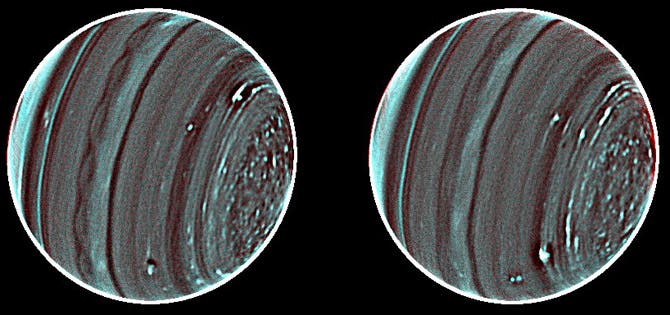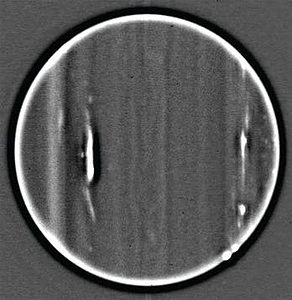The most detailed observations of the icy world of Uranus, the seventh planet from the sun, show complex weather patterns and other features that scientists have yet to fully describe.

The two faces of Uranus as seen through the adaptive optics on the near-infrared camera of the Keck II telescope in Hawaii. (c) Lawrence Sromovsky, Pat Fry, Heidi Hammel, Imke de Pater.
Popular belief had Uranus depicted as a bland, pale green world based on the now iconic observations from Voyager’s 1986 flyby of the planet. Its instruments from the time, however, weren’t sensitive enough to catch a more in-depth view, and since the planet is 30 times farther away from the sun than Earth, ground based telescopes couldn’t peel through its atmosphere because of noise.
A novel technique employed by an international team of scientists with telescopes of the Keck Observatory allowed for the first most detailed view of Uranus by combining multiple images of the planet in near-infrared. Thus, the scientists were able to reduce the noise and image weather features that are otherwise obscure, and these couldn’t be more interesting. Observations reveal circulating clouds, enormous hurricanes, and an unusual swarm of convective features at its north pole.
“These images reveal an astonishing amount of complexity in Uranus’ atmosphere,” said Heidi Hammel of the Association of Universities for Research in Astronomy. “We knew the planet was active, but until now, much of the activity had been masked by the noise in the data.”

A 2007 image of Uranus from the Keck telescope shows far less surface detail. Image courtesy of Imke de Pater.UC Berkeley.
The planet, in fact, looks like many of the solar system’s other large planets — the gas giants Jupiter and Saturn, and the ice giant Neptune — said Imke de Pater, professor and chair of astronomy at the University of California, Berkeley, and one of the team members.
Also atmospheric composition has been determined in greater detail than ever before, as data shows the clouds, which race at 560 miles per hour, are mainly composed of hydrogen, helium, and methane. This remarkable velocity came as a surprise to the researchers, since the planet is so far away from the sun, and thus should have lower energy available to drive these weather features.
“The sun is 900 times weaker than on Earth, so you don’t have the same intensity of solar energy driving the system as we do here,” said Larry Sromovsky, a planetary scientist at the University of Wisconsin, Madison, who lead the study. “Thus, the atmosphere of Uranus must operate as a very efficient machine with very little dissipation. Yet it undergoes dramatic variations that seem to defy that requirement.”
A distinct feature of Uranus, which greatly influences its now complex weather patterns, is the fact that it’s completely titled on its side. Opposite to how clouds travel from left to right on Earth, for instance, on Uranus the clouds run from up to down. Its North pole is, thus, on the right side. One new feature found by the group is a scalloped band of clouds just south of Uranus’ equator. The band may indicate atmospheric instability or wind shear.
“This is new, and we don’t fully understand what it means,” said Sromovsky. “We haven’t seen it anywhere else on Uranus.”
Like most large weather systems, which are probably much less violent than the storms we know on Earth, Uranus is fairly stable, despite exhibiting some strange patterns. Some stay at fixed latitudes and undergo large variations in activity, while others have been seen to drift towards the equator, while undergoing great changes in size and shape.
The findings will be presented at the American Astronomical Society’s Division of Planetary Sciences in Reno, Nev.
source: Berkley Uni









